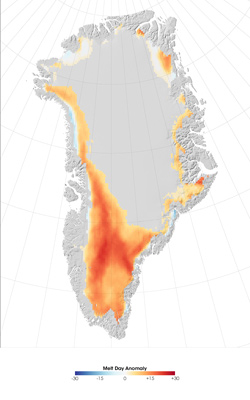NASA: warming is causing Greenland ice to melt faster than expected
NASA: warming is causing Greenland ice to melt faster than expected
mongabay.com
February 21, 2008
|
|
Warming air temperatures are causing Greenland’s ice sheet to melt faster than previously anticipated, reported NASA on Wednesday. Though unlikely, the complete melting of Greenland’s ice sheet would raise global sea level by 23 feet.
“The relationship between surface temperature and mass loss lends further credence to earlier work showing rapid response of the ice sheet to surface meltwater,” said Dorothy Hall, a senior researcher in Cryospheric Sciences at NASA’s Goddard Space Flight Center, and lead author of the study, published in the January issue of the quarterly Journal of Glaciology.

Microwave data from the Special Sensor Microwave Imaging radiometer was used to create this image of the 2007 Greenland melting anomaly which reflects the difference between the number of melting days occurring in 2007 and the average number of melting days during the period 1988 — 2006. Credit: NASA/Earth Observatory |
Using temperature data from the Moderate Resolution Imaging Spectroradiometer (MODIS) instrument on NASA’s Terra satellite and satellite gravity data from NASA’s Gravity Recovery and Climate Experiment (GRACE) twin satellite system, Hall and colleagues found “a strong connection between melting on ice sheet surfaces in areas below 6,500 feet in elevation, and ice loss throughout the ice sheet’s giant mass.”
The results seem to confirm that the start of surface melting “triggers mass loss of ice over large areas of the ice sheet.”
“We’re seeing a close correspondence between the date that surface melting begins, and the date that mass loss of ice begins beneath the surface,” Hall said. “This indicates that the meltwater from the surface must be traveling down to the base of the ice sheet — through over a mile of ice — very rapidly, where its presence allows the ice at the base to slide forward, speeding the flow of outlet glaciers that discharge icebergs and water into the surrounding ocean.”
“If air temperatures continue rising over Greenland, surface melt will continue to play a large role in the overall loss of ice mass.”